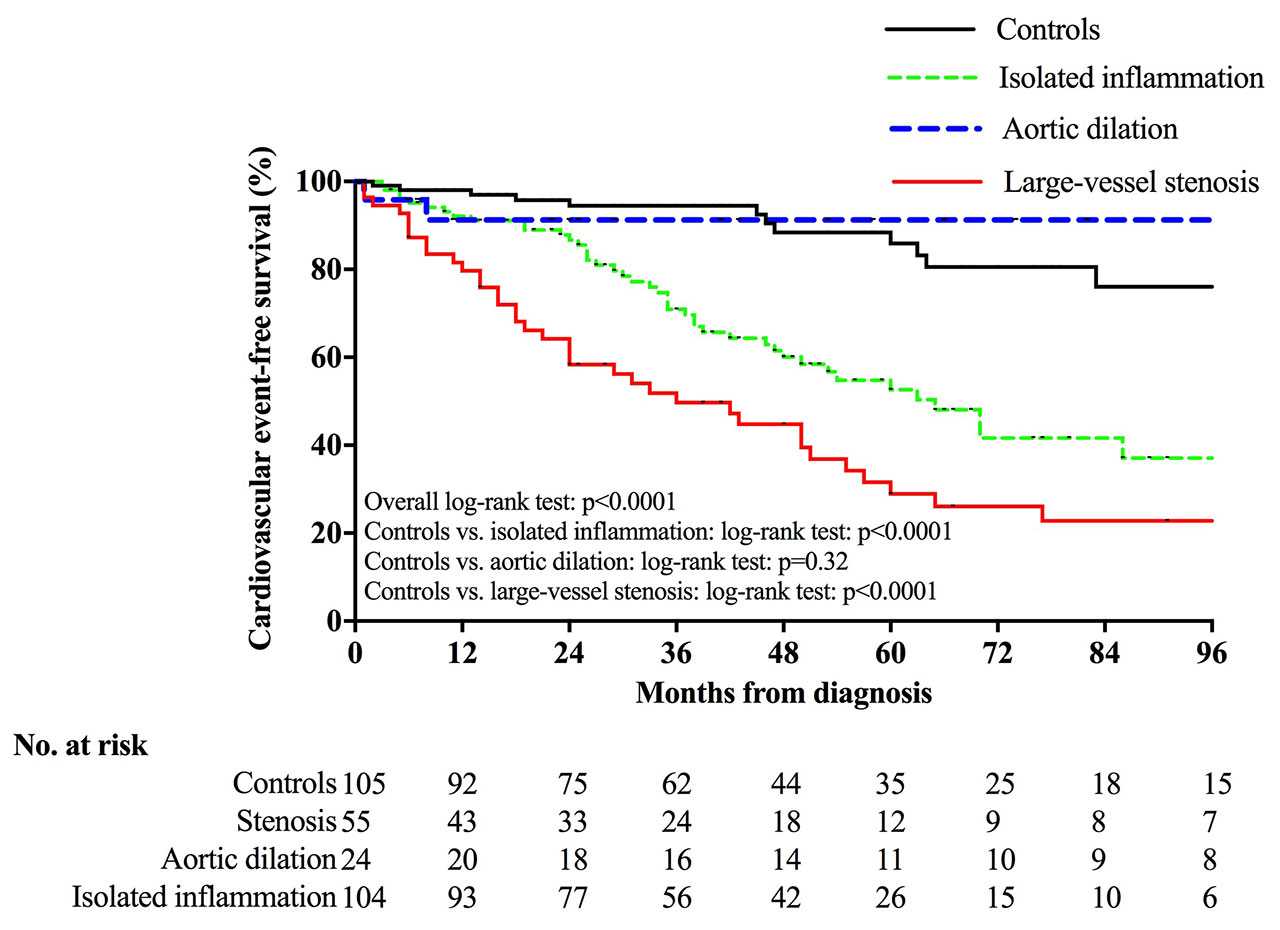Session Information
Session Type: ACR Abstract Session
Session Time: 2:30PM-4:00PM
Background/Purpose: Large-vessel involvements (LVI) in giant-cell arteritis (GCA) include different clinical and imaging patterns that are often pooled together in the published cohorts under the generic term “large-vessel vasculitis”. The analysis of the different imaging patterns in GCA patients with LVI and their relationships with patients’ cardiovascular prognosis have been poorly investigated.
Methods: We conducted a nationwide retrospective study and included GCA patients with LVI demonstrated on imaging at diagnosis between 2007 and 2017. We analyzed the prognosis of three different imaging patterns of LVI present at diagnosis, with some of them overlapping but with the first one present in all patients: 1) inflammation of the aorta and/or its branches; 2) dilation of the aorta; and 3) stenosis of the aortic branches. A control group of GCA patients without LVI was constituted.
A Cox proportional hazards model was used to assess predictive factors associated with new cardiovascular complications, ischemic events and aortic dilation. Hazard ratios (HRs) and 95% confidence intervals (CI) were computed for each predictor in the univariate analysis and in the multivariate model using the backward stepwise approach using variables that reached p < 0.1 in univariate analyses. We analyzed the cardiovascular event-free survival in patients with each different pattern of LVI and in controls, using life tables and the Kaplan-Meier method, and these were compared using the log-rank test.
Results: We included 183 patients with LVI and 105 controls without LVI. Altogether, among the 183 patients who all showed inflammation of the aorta and/or its main branches, concomitant aortic dilation and large-vessel stenosis were observed in 27 (15%) and 55 (30%) patients, respectively. During the follow-up period, new cardiovascular events occurred in 49% and 11% of LVI patients and controls, respectively (p < 0.0001). Inflammation of the aorta and/or its branches (HR: 3.42 [2.09-5.83], p < 0.0001) and large-artery stenosis (HR: 2.75 [1.80-4.15], p < 0.0001) were independent predictive factors of new cardiovascular events. Conversely, the use of an immunosuppressant besides corticosteroids was a protective factor against new cardiovascular events (HR: 0.44 [0.29-0.66], p < 0.0001) and the development of aortic dilation (HR: 0.43 [0.23-0.77], p = 0.005). ). The cardiovascular event-free survival in the three patterns and in controls is shown in the Figure. Patients with large-vessel stenosis showed the worst outcomes (log-rank test: p< 0.0001).
Conclusion: This study highlights that large-vessel involvement in GCA includes different clinical and imaging patterns that might influence cardiovascular outcomes. The involvement of the aorta and its branches at diagnosis may increase the risk of aortic dilation and dissection, whereas stenotic involvement of large vessels may favor the occurrence of ischemic events. In this study, the use of immunosuppressants in patients with LVI showed a protective impact on the occurrence of new cardiovascular events. A validation of this finding in other studies is required.
To cite this abstract in AMA style:
de BOYSSON H, LIOZON E, ESPITIA O, DAUMAS A, VAUTIER M, LAMBERT M, PARIENTI J, MANRIQUE A, Saadoun D, Ly K, Agard C, Aouba A. Different Patterns and Specific Outcomes of Large-Vessel Involvements in Giant Cell Arteritis [abstract]. Arthritis Rheumatol. 2019; 71 (suppl 10). https://acrabstracts.org/abstract/different-patterns-and-specific-outcomes-of-large-vessel-involvements-in-giant-cell-arteritis/. Accessed .« Back to 2019 ACR/ARP Annual Meeting
ACR Meeting Abstracts - https://acrabstracts.org/abstract/different-patterns-and-specific-outcomes-of-large-vessel-involvements-in-giant-cell-arteritis/

